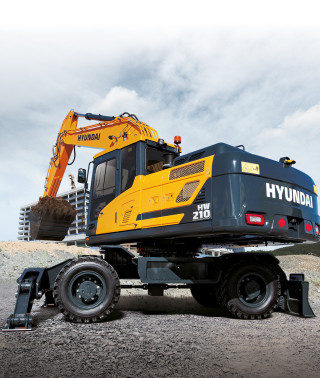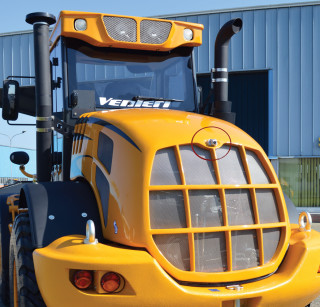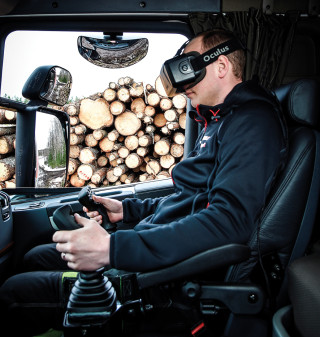Just as touch-screen satellite navigation systems have become commonplace in the latest passenger cars, so in-cab displays have become more sophisticated in construction machinery. No longer does the operator have to squint into a small black-and-white display; today’s cabs feature two or even three large LCD panels providing much more detail about operating conditions.
And along with these in-cab displays, external cameras have become mainstream – again, just as they have in cars. The difference, however, is that there is the force of legislation driving the increased adoption of camera technology in earthmoving machinery.
European and international standards relating to visibility from the cab of earthmoving machinery are currently being redrafted. In short, blind spots have to be eliminated, either by design or by technology.
It is, after all, well established that reversing vehicles are right up there with working at height as the greatest safety risks on construction sites.
Thus at Bauma there were more CCTV cameras mounted onto machines than ever before.
The new Komatsu Dash 11 demolition excavator, for example, comes with a standard rear-view camera to give the operator a wide landscape view of the area directly behind the machine. This is now incorporated, along with the gauges, as the operating default screen. A second camera is also available as an optional extra.
A camera is also standard on the new HB365LC-3 hybrid excavator as well and as an option on the PW98MR-10 midi excavator.
New Doosan excavators, such as the wheeled 19-tonne DX190W-5, have the option of a side-view camera as well as a rear-view camera. The images from both the rear and side-view cameras can be combined on the same screen by pressing a button on the control panel.
For more safety when using the cameras, a menu bar now stays open so that the operator can keep an eye out for warning symbols and the levels of key gauges.
Also on display was a 13.63B wheeled loader from Italian manufacturer VF Venieri fitted with the new Backeye360 Select system from Brigade Electronics, a system specifically designed to eliminate blind spots.
The Backeye360 system provides a bird’s-eye view of the area surrounding the vehicle by stitching together images from four cameras located on the machine and creating a single 360o view. The image appears on the monitor in the cab, ensuring there are no blind spots.
According to Brigade’s marketing manager Emily Hardy, the company has seen a sharp increase in sales of its systems to users in the construction industry. “Although not mandatory by law, the fitting of these safety devices has become best practice,” she says.
Korean manufacturer Hyundai clearly agrees, since it was also promoting very similar technology in the form of its Advanced Around View Monitoring (AAVM) camera system, which is available as an option on its new range of excavators.


The AAVM system resembles the Backeye360 insofar as it also uses four cameras to generate a 360o image of the area around the machine; nevertheless Hyundai insists that it is different from, and safer than, anything else on the market. It secures a field of vision in all directions with 10 different viewing options including a 3D bird’s eye view and 2D/4CH, using touchscreen technology.
Hyundai’s new camera system also incorporates something it calls IMOD, which stands for Intelligent Moving Object Detection. This sounds an alarm when anyone or anything is detected within a 5m radius of the excavator and a rectangle appears around the object or person on the 203mm monitor to highlight the danger.

Cameras for virtual reality
If the latest batch of CCTV systems represent the state of the art, Swedish loader crane producer Hiab is promoting something that might just possibly be the future: virtual reality machine operation.
Strictly speaking, the “virtual reality” tag is a misnomer. “Virtual” suggests a simulation but with this system the operator really does operate the machine, except from a safer position.
Given that most lorry loader cranes can now be operated by remote control, finding somewhere safe to stand, clear of the crane and the load, is not so much an issue for the operator these days. But with Hiab’s HiVision 3D control system, the operator does not even need to be in the same vicinity as the crane.
“Based on the recent advancements in virtual reality goggles, cameras, and connectivity we have developed a system with cameras on top of a forestry crane, which enables you to see the working area and operate the crane remotely using VR goggles,” says Rafal Sornek, vice president for technology and quality development at Hiab.
HiVision uses four cameras located in a small box where the operator’s head would normally be to enable a 240o view. The operator puts on the goggles and controls the crane from the driver’s cab. When the operator turns his head the goggle image switches from two forward-looking cameras to two sideways cameras.
Henrik Strömbäck from Swedish haulage contractor JS Frakt tried out HiVision at Hiab’s R&D facility in Hudiksvall. “The system exceeded my expectations. For sure, it’s very different compared to the traditional way. Still, there’s no need to relearn the way you work. You don’t have to climb out in the cold – everything is close by and you can start loading immediately when you arrive at the working site. You have a surprisingly wide field of vision,” he says.
For Hiab the possibilities are not just about staying warm in the cab. “In the future the operator doesn’t even have to be in the truck, but operates remotely from a distance, saving costs,” says Rafal Sornek. “I’m a strong believer that quite soon we will have driverless trucks on the roads, and it makes no sense to have crane operators sitting on these waiting passively to get to the site. One person could even operate several trucks remotely,” he says

Got a story? Email news@theconstructionindex.co.uk


